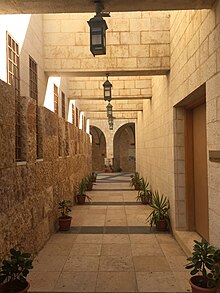Al-Shunah Al-Shamalyah
Etymology
Shunah translates in the region's Arabic to "barn". Shunah is also spelled Shuneh and Shuna.
The Arabic definite article al when followed by certain consonants undergoes assimilation to the latter, so that in cases like this, al is sounded ash, also spelled esh, yielding here ash-Shunah/esh-Shuneh. Likewise al-Shamalyah is often rendered ash-Shamaliyah/esh-Shamaliyeh.
For the beginning of place-names, at least when reproduced in English, common convention allows for the definite article to be dropped, yielding here Shunah (Shuneh/Shuna).
Sham is Arabic for "north", and al-shamaliyah means "northern". Therefore, Al-Shunah al-Shamaliyah translates to, and is often rendered in English, as "North Shuna" or "Northern Shuna". Another place called Shunah, a village located at the opposite, southern end of the Jordan Valley, is known as South Shuna.
Demographics
The Jordanian census of 1961 found 3,462 inhabitants in Al-Shuna al-Shamalyah, while the website www.arabs48.com mentions 25,000 inhabitants in 2014.
Sites
Tell esh-Shuneh (North)
In 1953, archaeologists Henri de Contenson and James Mellaart excavated the site of Tell esh-Shuneh esh-Shamaliyyeh (Tell Shuneh North), overlooking the Wadi el-'Arab, just outside of the city. The site was re-excavated in the 1980s by Carrie Gustavson-Gaube and again in the 1990s by Durham University. The artifacts recovered from Tell esh-Shuneh (North) include remains of structures, pottery, and silver dating from the Chalcolithic and Early Bronze Age. Excavations also uncovered numerous macrobotanical remains, suggesting that both Chalcolithic and Early Bronze Age settlements at the site utilized agricultural irrigation.
Shrine of Muadh ibn Jabal

The tomb of Muadh Ibn Jabal (official name in Arabic: مقام الصحابي الجليل معاذ بن جبل رضي الله عنه, romanized: The shrine of the great companion Muadh bin Jabal, may God be pleased with him), a prominent Sahabah of Muhammad and compiler of the Quran, is located in Al-Shuna al-Shamalya. The tomb is noted for its pleasant, yet allegedly unexplained smell.
North Shuna used to be called Shunat Muadhi due to its proximity to the tomb of Muadh ibn Jabal.
References
- ^ Dr. Muhammad Aqel (2014-05-24). "موقع عرب 48". موقع عرب 48 (in Arabic). Retrieved 2016-12-11.
- ^ United States Board on Geographic Names (1990). Gazetteer of Jordan: Names Approved by the United States Board on Geographic Names (2 ed.). Washington, D.C.: Defense Mapping Agency. p. 273. Retrieved 23 January 2022.
- ^ Conder, C. R. (1889). The Survey of Eastern Palestine. Memoirs of the Topography, Orography, Hydrography, Archaeology, etc (PDF). London: The Committee of the Palestine Exploration Fund. pp. 216, 218. Retrieved 27 January 2022.
- ^ Ritter, Robert M. (2002). The Oxford Guide to Style (PDF). Oxford: Oxford University Press. pp. 252–256. ISBN 0-19-869175-0. Retrieved 21 January 2022. (See Hart's Rules).
- ^ Rajki, András (2005). Arabic Dictionary with Etymologies. Accessed 5 September 2018.
- ^ The North Shuna-South Shuna Road Project, Japan International Cooperation Agency (JICA). Accessed 27 Jan 2022.
- ^ Government of Jordan, Department of Statistics, 1964, p. 14
- ^ Kafafi, Zeidan. "Henri De Contenson's Archaeological Fieldwork in the Eastern Part of the Jordan Valley: A Re-Evaluation". IFPO - Institut Français du Proche-Orient.
- ^ Graham, Philip; Rehren, Thilo (January 1996). "Fourth millennium BC silver from Tell esh-Shuna, Jordan: archaeometallurgical investigation and some thoughts on ceramic skeuomorphs". Oxford Journal of Archaeology. 15 (2): 129–150. doi:10.1111/j.1468-0092.1996.tb00080.x. ISSN 0262-5253.
- ^ Jenkins, Emma; Baker, Ambroise; Elliott, Sarah (2011), "Past plant use in Jordan as revealed by archaeological and ethnoarchaeological phytolith signatures", Water, Life and Civilisation (PDF), Cambridge University Press, pp. 381–400, doi:10.1017/cbo9780511975219.023, ISBN 9780511975219
- ^ Blogger, Rawabat (2016-12-04). "Jordan and Jerusalem 2016: > Chasing the Fragrant Grave of Muadh Ibn Jabal". Jordan and Jerusalem 2016. Retrieved 2018-11-20.
- ^ Dr. Muhammad Aqel (2014-05-24). "موقع عرب 48". موقع عرب 48 (in Arabic). Retrieved 2022-01-27.
Bibliography
- First Census of Population and Housing. Volume I: Final Tables; General Characteristics of the Population (PDF). Government of Jordan, Department of Statistics. 1964.